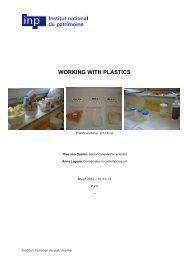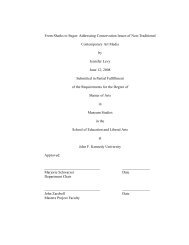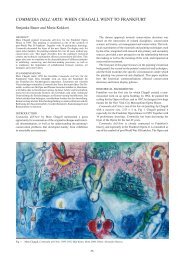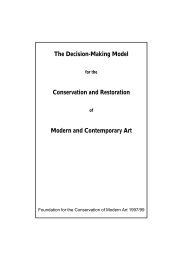Conservation Issues of Modern and Contemporary Art ... - The Getty
Conservation Issues of Modern and Contemporary Art ... - The Getty
Conservation Issues of Modern and Contemporary Art ... - The Getty
Create successful ePaper yourself
Turn your PDF publications into a flip-book with our unique Google optimized e-Paper software.
ISSUES<br />
<strong>The</strong> primary issues identified by the meeting participants were grouped into six broad<br />
categories:<br />
• research into modern materials;<br />
• research into conservation treatments;<br />
• ethical/theoretical issues;<br />
• documentation;<br />
• dissemination <strong>and</strong> information sharing;<br />
• education <strong>and</strong> training.<br />
Research into <strong>Modern</strong> Materials<br />
Despite recent <strong>and</strong> significant advances in the conservation pr<strong>of</strong>ession’s knowledge <strong>of</strong><br />
some <strong>of</strong> the materials used in modern <strong>and</strong> contemporary art—in particular, modern<br />
paints—there remains a severe lack <strong>of</strong> information regarding the vast majority <strong>of</strong><br />
modern/contemporary materials, in terms <strong>of</strong> underst<strong>and</strong>ing how they behave (either<br />
alone or in combination with other materials), <strong>and</strong> how they might alter with age, in<br />
storage, with treatment, <strong>and</strong>/or in transit, etc. Specifically, there is a clear need for:<br />
• further characterization <strong>of</strong> these materials to underst<strong>and</strong> their chemistry <strong>and</strong><br />
condition, <strong>and</strong> how they are likely to alter/deteriorate with age;<br />
• improved access to existing methods <strong>of</strong> analysis <strong>and</strong> characterization, especially<br />
for private studios/smaller museums, either through h<strong>and</strong>-held instruments or<br />
closer collaborations with analysts/conservation scientists;<br />
• more portable analytical instruments for in situ identification <strong>of</strong> materials in<br />
actual objects—in particular, for rapid surveying <strong>of</strong> large collections <strong>of</strong> disparate<br />
materials;<br />
• more portable analytical instruments for in situ monitoring <strong>of</strong> chemical,<br />
physical, <strong>and</strong>/or surface changes in objects with age <strong>and</strong>/or after treatments;<br />
• better documented, accessible, <strong>and</strong> reliable collections <strong>of</strong> reference materials<br />
with which analytical methods for identification can be developed <strong>and</strong> aging<br />
studies conducted;<br />
• establishing the optimum environmental conditions/strategies for the display<br />
<strong>and</strong> storage <strong>of</strong> all modern <strong>and</strong> contemporary materials;<br />
• determining guidelines for the packing <strong>and</strong> transportation <strong>of</strong> modern <strong>and</strong><br />
contemporary works <strong>of</strong> art.<br />
Research into <strong>Conservation</strong> Treatments<br />
Conservators <strong>of</strong>ten have to carry out treatments on modern <strong>and</strong> contemporary art<br />
works with a limited range <strong>of</strong> appropriate materials <strong>and</strong> treatment options, <strong>and</strong><br />
without the desired level <strong>of</strong> underst<strong>and</strong>ing <strong>of</strong> the materials/process themselves <strong>and</strong>/or<br />
the long-term consequences <strong>of</strong> their use. <strong>The</strong>re appear to be two main factors<br />
hampering progress in this area: 1) a lack <strong>of</strong> research focusing on developing new <strong>and</strong><br />
novel conservation treatments <strong>and</strong>/or materials; <strong>and</strong> 2) a lack <strong>of</strong> experience <strong>and</strong> case<br />
studies on which conservators can evaluate the longer-term success <strong>of</strong> previous<br />
treatments. In many cases this has lead to reluctance by conservators to execute<br />
treatments—which, in turn, means that future generations <strong>of</strong> conservators may have<br />
access to even fewer case studies on which they can establish the success or failure <strong>of</strong><br />
treatments.<br />
2
















